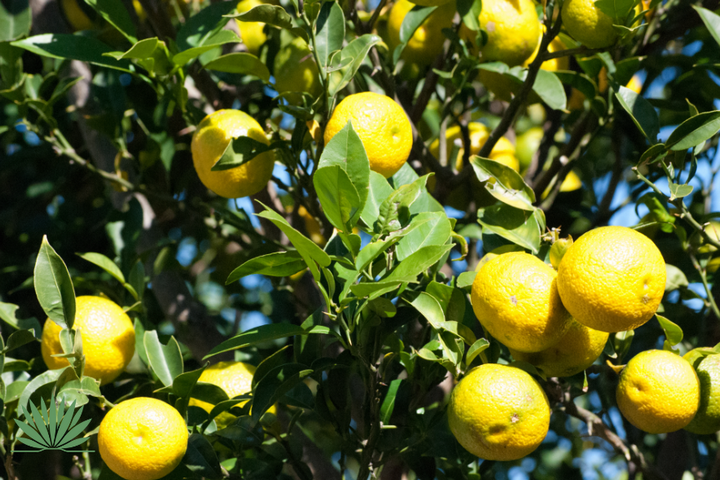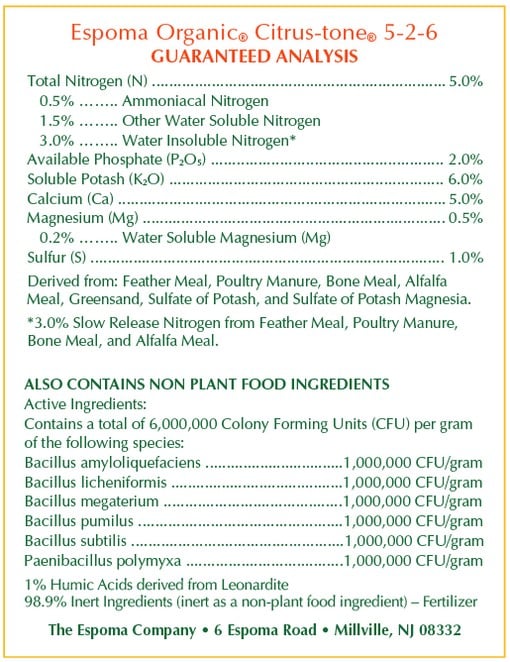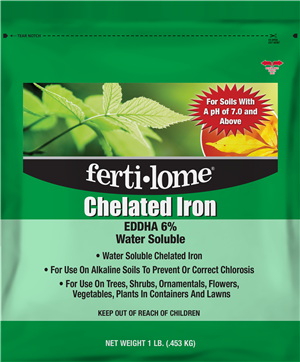If you grow citrus trees in the desert southwest, it’s important that you fertilize them to keep them healthy, attractive, and productive. But there’s more to it than haphazardly sprinkling some fertilizer around the tree. Learn how to fertilize citrus the right way for optimal results.

Growing citrus is a rewarding way to have an attractive landscape plant that doubles as a food source. One of my first Tucson homes had mature orange and lemon trees. Having moved from Maryland, being able to pick lemons and oranges off the tree was a delightful novelty!
But to keep citrus healthy, looking their best, and producing delicious, juicy fruit, requires care, including fertilizer. Many gardeners take a cavalier approach to fertilizing. They buy a bag labeled “citrus fertilizer”, toss some on the ground, and call it a day. (That used to be me. 🫣) But for optimal results, fertilizing is a little more complicated than that.
You need to know when to fertilize, how much fertilizer to apply, and what to look for in a citrus fertilizer.
First, let’s take a quick look at why you should fertilize your citrus trees.
Why Fertilize Citrus?
Citrus tree can produce copious amounts of fruit, consequently, they need a lot of nutrients. Properly fed trees are healthier and more resilient to whatever the desert throws at them — temperature extremes, drought, pests, and diseases. Healthy trees produce better yields and tastier fruit.
Nitrogen is the most important nutrient for an overall healthy tree and for fruit yield and quality. When nitrogen is in short supply, trees are less robust. Growth is stunted and leaves turn yellow. They produce less fruit and it’s of lower quality. It isn’t as colorful, juicy, tasty, or nutritious.
Furthermore, citrus trees are not native to the desert southwest and have not evolved to exist in native soils. Their preference would be to grow in fertile, slightly acidic soil. While we can grow citrus in the southwest because we have a suitable climate, our soil is not ideal. It’s alkaline and low in organic matter. We can help our trees along by providing organic matter in the way of fertilizer, compost, and/or organic mulch.
When to Fertilize Citrus?
Citrus should be fertilized three times per year.
The “old way” used to be that you fertilized on certain holidays, such as on Valentine’s Day, Mother’s Day, or Labor Day. This was suggested largely to help gardeners remember to fertilize, but this schedule has been revised.
It’s now recommended that you fertilize according to the following schedules. (Not all citrus should be fertilized on the same schedule.)
The “sours” (lemons, limes) should be fertilized on this schedule:
- January – February
- March – April
- August – September
Oranges, tangerines, and grapefruit should be fertilized on this schedule:
- January – February
- March – April
- May – June
You can still link these times to holidays if it helps you remember. 😉
How Much Fertilizer to Apply?
Until recently, determining how much fertilizer to apply was somewhat complicated and involved doing some math. Lucky for us, the University of Arizona has created this Citrus Fertilization Calculator.
You’ll only need to enter three pieces of information and it will tell you how much fertilizer you should apply. It’s free and you can use it as often as you’d like.
Before using the calculator, have this information ready:
- Tree type. Your choices will be lemon, lime, orange, grapefruit, kumquat, pomelo, tangerine, and other.
- Tree size. Know your tree’s approximate height, trunk diameter, and canopy diameter.
- Your fertilizer’s nitrogen content. You can find this on your fertilizer’s label. It’s the “N” number.
You may be surprised at how much fertilizer you should apply. The first time I got “scientific” about fertilizing my trees, I realized I had been dramatically under-fertilizing them.
What Kind of Fertilizer to Use?
When you go shopping for fertilizer, you’ll be faced with a many choices — citrus vs all-purpose, organic vs synthetic, and various amounts of nitrogen. Let’s take a look at these variables and their significance.
Citrus vs All-Purpose
I’m not a fan of buying a different fertilizer for every kind of plant. You can find fertilizers sold specifically for citrus, roses, houseplants, orchids, tomatoes, succulents, and more. (Sometimes, it’s necessary, such as in the case of palm fertilizer.) But this is largely a marketing ploy to get you to buy more stuff.
In the case of citrus, I’d say a special citrus fertilizer is “nice but not necessary.” A comparable all-purpose fertilizer should be sufficient.
If you look at a fertilizer label, you’ll see a ratio listed that looks like this: 10-4-6. This indicates the percentage by weight of the macronutrients nitrogen (N), phosphorus (P), and potassium (K).
Every company’s formulation will be different, but here’s a label of a typical citrus fertilizer, specifically Epsoma’s organic citrus fertilizer. You’ll notice the macronutrient composition is 5-2-6.

I compared this to Epsoma’s organic all-purpose fertilizer. It is nearly identical to their citrus fertilizer except its macronutrient composition is 5-3-3 instead of 5-2-6. Since the amount of nitrogen is by far the most important, I’d be satisfied using either.
Synthetic vs Organic
Organic fertilizers improve your soil by adding organic matter and encouraging the growth of beneficial microbes. And since they don’t break down as fast as synthetic fertilizers, their effects last longer, and they are less likely to cause fertilizer burn.
On the other hand, if you have reason to believe your plant has a genuine nutrient deficiency, synthetic fertilizers are more quickly absorbed and get to work on deficiencies faster. If you use a synthetic fertilizer, be careful not to over-fertilize which can cause fertilizer burn.
When to Supplement with Iron
So far, we’ve covered citrus’s need for the macronutrient nitrogen. But iron is by far the most common micronutrient deficiency in citrus, and can occur even if you follow good fertilizing practices.
Unlike native plants, which have evolved to absorb the iron they need from our high pH soils, citrus can’t do this. Consequently, citrus is at risk for a deficiency called iron chlorosis. It affects new leaves and is characterized by yellow leaves with distinctly green veins.

The recommended treatment is to apply a chelated iron supplement. Chelated means that the iron molecules are bonded to another substance to create a form that plants can utilize.
Note that most iron supplements are designed to green up lawns, not citrus. Look for one that states Fe-EDDHA or EDDHA on the label. (EDDHA refers to the chelating agent used to make the iron absorbable.) Here’s a label of an iron supplement that contains EDDHA.

You can learn more about diagnosing and treating iron chlorosis in our article Why Desert Plants Get Iron Chlorosis (& what to do).
Essential Fertilizing Tips!
🍋 The main reason you are fertilizing is to provide nitrogen. The amount of nitrogen in fertilizers varies greatly, so look for a fertilizer that is comparatively high in nitrogen. You will need to use less of it, which can save you money. Look for a fertilizer with a ratio of nitrogen to phosphorus that’s close to 2 to 1.
🍊 Evenly sprinkle fertilizer at your tree’s drip line. This is where feeder roots are most active. Lightly work it in as best as you can. You can move away any mulch or gravel, fertilize, and move it back, but it’s not necessary. Then water thoroughly. This will prevent it from blowing away or volatilizing and start moving it down to the roots.
🍋 While you can try to fertilize before a rain, doing so can be dicey. You need to be pretty sure you won’t be having a gully washer, which can wash your fertilizer away.

🍊 Don’t fertilize newly planted citrus the first year. You want your plants to put their energy into developing a healthy root system. Fertilizer stimulates flower and fruit production, instead. However, you can top dress with compost or organic mulch which breaks down slowly and improves the soil.
🍋 Too much fertilizer can be as detrimental as not enough. It can result in excessive growth that is more susceptible to pests and diseases. A sign your tree has received too much nitrogen is fruit with overly-thick rinds.
🍊 Citrus trees grown in pots should be fertilized more frequently and be given smaller amounts. A good rule of thumb is to fertilize once per month February through October, skipping the hottest months of June and July. Plants take up nutrients less efficiently during extreme heat and are more susceptible to fertilizer burn.
Fertilizing Citrus: The Bottom Line
While there are many details to consider, here’s a summary of the key points:
- Buy either an all-purpose or citrus fertilizer, paying particular attention to the amount of nitrogen it contains.
- Use the Citrus Fertilization Calculator to determine how much fertilizer to use with each application.
- Fertilize three times per year, according to that fruit’s recommended schedule.
That’s it! I hope I’ve made fertilizing citrus a little less confusing and that your next harvest is a great one.
Did you enjoy this article?
Sign up for our weekly newsletter
where you’ll find more great info on creating &
maintaining a beautiful, carefree desert landscape.
Author Bio
Deane Alban is the creator of Southwest Gardener. She is a science writer with a bachelor’s degree in botany from the University of South Florida. Gardening is her lifelong passion. She’s been gardening in Tucson for over 15 years.

